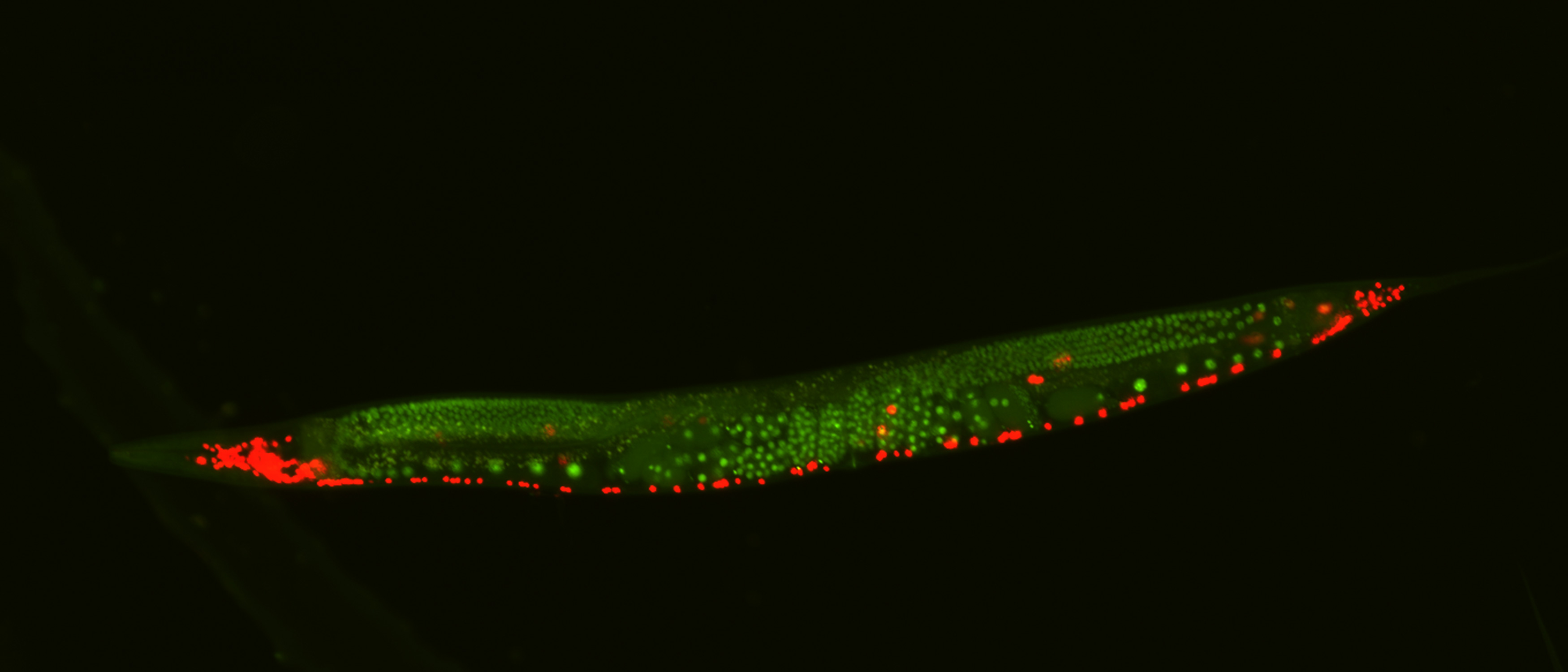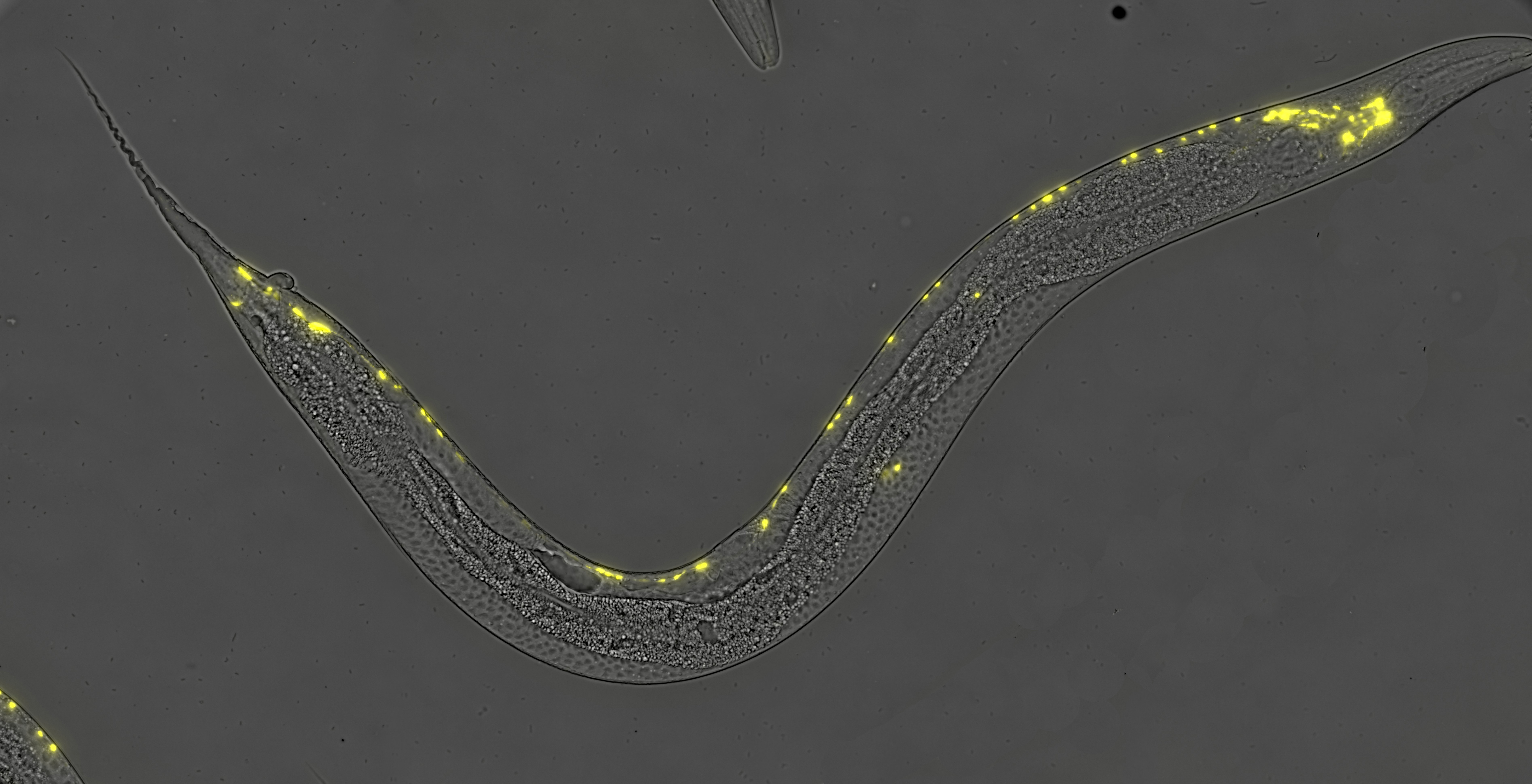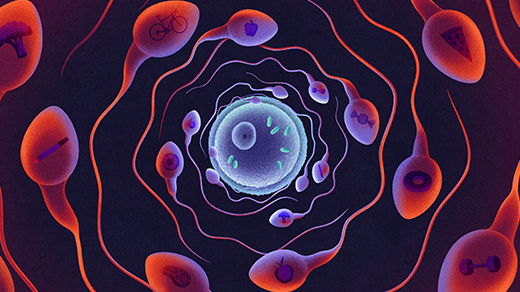Inherited Learning? It Happens, but How Is Uncertain

Memories passed down in our genes? Not exactly. But biologists have observed examples of learned behaviors and acquired responses being transmitted through several generations, contrary to the traditional rules of genetic inheritance.
Lucy Reading-Ikkanda/Quanta Magazine
Introduction
As a biological concept, the inheritance of acquired characteristics has had a wild roller coaster ride over the past two centuries. Championed by Jean-Baptiste Lamarck at the beginning of the 19th century, it soared to widespread popularity as a theory of inheritance and an explanation for evolution, enduring even after Charles Darwin published On the Origin of Species. Then experimental tests, the rise of Mendelian genetics, and the wealth of discoveries substantiating chromosomal DNA as the principal medium of genetic information in complex organisms all but buried the idea until the mid-20th century. Since then, the theory has found at least a limited new respectability with the rise of “epigenetics” (literally, around or on top of genetics) as an explanation for some inherited traits.
Most recently, some researchers have found evidence that even some learned behaviors and physiological responses can be epigenetically inherited. None of the new studies fully address exactly how information learned or acquired in the somatic tissues is communicated and incorporated into the germline. But mechanisms centering around small RNA molecules and forms of hormonal communication are actively being investigated.
“The major outstanding question is not whether these [epigenetic inheritance] effects are happening, but what are the mechanisms by which these changes are happening,” wrote Nicholas Burton, an epigenetics researcher at the University of Cambridge, in an email. “There is certainly still spirited debate on this topic and I suspect this debate will continue for awhile yet. It will be very exciting to see what comes of it.”
The evolutionary “why” for epigenetic inheritance is also an area of active investigation because it’s paradoxical. If learned adaptive behaviors can be passed on to the next generation, that would seem to eliminate the necessity for certain standard evolved changes to the genome. On the other hand, if epigenetically transmitted traits are adaptive, why not hardwire them into the genome so that they can be inherited more stably?
Breaching a Generational Barrier
The death knell for the theory of Lamarckian inheritance was sounded in part by work from the German evolutionary biologist August Weismann published in 1892. He posited that traits acquired through exposure to the environment could not pass from the somatic (body) cells of a complex organism into the germline tissues responsible for eggs and sperm, and then on to the next generation. This principle, known as the Weismann barrier, quickly became a mainstay of genetics.
But in the 1950s, the botanist Royal Alexander Brink discovered that, under different environmental conditions, maize plants with identical genomes expressed different-colored kernels, and these colors were heritable. It was some of the first evidence for epigenetic inheritance. Since then, more examples of inheritance without a clear genetic basis have come to light, as have a variety of possible mechanisms for epigenetic inheritance. Typically, these mechanisms have involved either chemical modifications of the proteins and DNA in the “chromatin” that makes up chromosomes, or small molecules of RNA that pass into germ cells, where they interact with the DNA and affect gene regulation.

In this C. elegans roundworm, the germ cells that make sperm and eggs are marked with a green fluorescent protein, while the neurons are marked with a red one. Adaptive responses learned by these worms cause changes in the neural system. What is still unclear is how corresponding changes are sometimes induced in the germ cells, allowing the worm’s progeny to exhibit the same behaviors.
Dana Landschaft, 2019, Tel Aviv
Still, it wasn’t clear whether a learned behavior, encoded by changes in the nervous system, could be biologically transmitted from parent to offspring. Researchers regard the question with cautious skepticism, perhaps in part because of well-known, discredited studies from the 1960s involving flatworms (planaria). The researcher James McConnell trained flatworms to navigate a maze; he then ground up the animals and fed them to a new set of flatworms, which seemingly learned the maze more quickly. These results proved hard to replicate and were later mostly dismissed as artifacts of poor experimental design. But the question still tantalized scientists.
“The possibility that the nervous system could generate heritable responses was especially intriguing, because the nervous system is a very unique system in its ability to organize information about the environment,” said Oded Rechavi, a neurobiologist at Tel Aviv University who studies inheritance and evolution. “It has [a] unique capability of planning.”
Rechavi is one of the scientists behind a series of studies published in the past few months that point to small noncoding RNAs — RNA molecules that serve functions other than the production of peptides — as key mediators of some epigenetic effects in a simple model animal, the roundworm Caenorhabditis elegans. Different mechanisms, probably including ones as yet unknown, may govern other instances of inherited learning in the worms and in more complex organisms. Indeed, some scientists don’t agree that small noncoding RNAs have a singularly important role in the phenomenon at all. And in general, researchers are cautious in approaching the argument that epigenetics enables the transmission of specific, adaptive traits to new generations.
Heritable Small RNAs From Neurons
Almost a decade ago, as a postdoctoral fellow at Columbia University, Rechavi showed that C. elegans worms infected with viruses would defend themselves by generating small RNAs that targeted and neutralized the viruses. Moreover, the subsequent offspring of the roundworms also made these small protective RNAs, even though they had never been exposed to the viruses. That study, published in Cell in 2011, showed that stress could induce the production of small RNAs that helped with an adaptive response, and that these RNAs were heritable. He also showed that the inheritance of the small RNAs depends on certain enzymes (RNA-dependent RNA polymerases) that can replicate those RNAs from a messenger RNA template.
In his latest study, published in the June 13 issue of Cell, Rechavi investigated the inheritance of a learned behavior: chemotaxis, the ability to orient and move toward food sources. He wanted to know whether small RNAs made specifically in nerve cells could somehow communicate with the germline and generate heritable behavioral responses.
To find out, Rechavi and his colleagues engineered a mutant worm that lacks a gene, rde-4, required both for the synthesis of small RNAs and for chemotaxis. Without the small RNAs that rde-4 makes, the worms can’t sniff out food if they are subjected to mild stresses like slightly elevated temperatures.
The researchers then restored the missing gene only in the mutant worms’ nerve cells. The procedure restored the worms’ ability to locate food. Further work determined that the worms’ chemotaxis depended mainly on so-called small interfering RNAs (siRNAs) that muted the effects of a particular gene, saeg-2, in the neurons.
The surprise came when they looked at the worms’ gonads: More than 1,000 siRNAs had changed in abundance relative to those in worms that lacked rde-4 entirely. And although none of the progeny’s cells carried a working rde-4 gene, the worms could still perform chemotaxis. Somehow, their germ cells still had siRNAs targeting saeg-2. Rechavi and his colleagues concluded that these worms had inherited the siRNAs from their parents — evidence that the production of specific small RNAs in the parental neurons could generate a heritable response that showed up in the worms’ progeny.
Peter Sarkies, an epigenetics researcher at Imperial College London, says he is excited about “the idea that information can be transmitted from the nervous system into the germline and then … transgenerationally,” with an impact on the defendants’ nervous system as well. Nevertheless, he cautions that “it’s a slightly artificial system, because the worm has been engineered in order to test the idea. It is not a wild-type worm.”

This mutant roundworm created in Rechavi’s laboratory would not ordinarily be able to navigate to food. A gene inserted only into the worm’s neurons, however, restored that ability; a yellow marker protein reveals the cells expressing that gene. Surprisingly, the worms’ offspring can also find food, possibly because specific small RNA molecules from the parent’s neurons induced a heritable change in its germ cells.
Rechavi says that exactly how the changes in the neurons are communicated to the germline and how that affects the nervous system of the next generation are still open questions. He hypothesizes that the process involves one or more molecules released by the nervous system — perhaps small RNAs, perhaps something secreted like a hormone. But somehow those germ cells then influence the behavior of the next generation and seem to circumvent the normal need for rde-4 in the production of the small RNAs for chemotaxis in the progeny.
In another paper on epigenetic behavior that appeared in the same June issue of Cell, Rebecca Moore, Rachel Kaletsky and Coleen Murphy, the molecular biologist who leads their laboratory at Princeton University, reported that C. elegans worms exposed to the pathogenic bacterium Pseudomonas aeruginosa learn to avoid it, and they transmit this learned avoidance for approximately four generations. Normally, the worms seem to prefer Pseudomonas to the bacteria on which they routinely feed.
The researchers sought to understand how this behavior is controlled at a molecular level. They discovered that double-stranded RNA from the pathogen triggered the worms’ response, a finding that they further investigated with Lance Parsons of Princeton University and described in a biorxiv preprint posted on July 11.
In the worms exposed to the pathogen, they detected changes in the expression of a gene, daf-7, in a specific neuron called ASI that is required for the avoidance behavior. They also found a “huge number of changes” in the small RNAs in the germline, Murphy said, including the ones called Piwi-interacting RNA (piRNA). As the name suggests, piRNAs interact with piwi genes, which help to regulate stem cell differentiation.
Moore, Kaletsky and Murphy found that animals without the piRNA pathway can learn to avoid Pseudomonas but do not pass on this avoidance behavior to their progeny. Thus, the piRNA pathway is critical for inheritance of the behavior. “That’s why we’re excited about the piRNA pathway,” Murphy said.
Sarkies thinks these findings may help to explain the curious ability of C. elegans to take up double-stranded RNA from the environment and use it to silence endogenous genes. For years, geneticists have exploited this property of worms: By synthesizing double RNAs that match any gene, researchers can silence it and study what it does.
But why the worm has this ability was mysterious. “It obviously didn’t evolve it in order to make life easy for scientists, and we don’t really understand what ecological role it might have,” Sarkies said. “What’s quite exciting in principle about the studies from the Murphy lab is that they suggest that this might be a way in which C. elegans is able to adapt to pathogenic bacteria.” Hypothetically, when the worm takes up double-stranded RNA from bacteria in its environment, the molecules could silence some of the worm’s genes and induce adaptive responses. Those adaptations could then be passed to the next generation.
Most in the field still approach such conjectures with skepticism. “I believe that today, there is not a single solid paper showing that only small RNAs are involved in epigenetic inheritance,” said Isabelle Mansuy, a neuroepigenetics researcher at the Swiss Federal Institute of Technology Zurich and the University of Zurich who studies the inheritance of trauma in humans and mice. In the mouse model she works with, she knows that small RNAs are not sufficient because if she injects small RNAs alone into fertilized mouse eggs, the resulting animals do not show the RNA-associated trait.
Mansuy believes that a multitude of factors may contribute in different ways to epigenetic inheritance, and their importance may vary with the trait or behavior. “Very often people like to simplify the matter and think either it’s DNA methylation or it’s microRNA. I think it’s totally misleading to think that way,” she said. “People should not dismiss one or the other but just think about all these factors together.”
She added that errors have crept into the literature on epigenetic inheritance, making some findings seem more definitive than they are. For example, some review articles claim that Mansuy demonstrated that injecting microRNAs into fertilized eggs is sufficient to cause the inheritance of behavioral symptoms in mice. “We never showed this,” she emphasized. Authors of review articles often don’t go back to check the original findings, so when the review is cited subsequently, it creates an “auto-feeding system” that perpetuates errors. “It’s polluting the field,” she said. Now many people work only on RNA epigenetic inheritance because they think it is well established, she added.
Unreliable findings have also sometimes appeared in high-profile journals. As a result, she argues, the field as a whole may be on thinner ice than it seems. “The lack of rigor can lead to a misleading thought and perception,” she warned.
Small RNAs Don’t Do It All
Validation of Mansuy’s skepticism can be found in a recent study in eLife on epigenetic inheritance in fruit flies. Giovanni Bosco and his colleagues at Dartmouth College demonstrated that learned adaptive behaviors in fruit flies can be epigenetically inherited — but that small RNAs are not sufficient to transmit this behavior.
In Drosophila, adult females raised with parasitic wasps learn to lay their eggs on food that contains ethanol, which protects the eggs and larvae from being parasitized by the wasps. This egg-laying preference occurs even when the mother herself was never exposed to ethanol, Bosco emphasized. “Exposure to the wasp was in and of itself sufficient for the females to somehow epigenetically reprogram their eggs so that their daughters would be predisposed to have this behavior,” he said.
The preference for egg laying on ethanol persists for five generations. Bosco, his graduate student Julianna Bozler, and Balint Kacsoh (now a postdoc at the University of Pennsylvania) hypothesized that small RNAs were involved in the inheritance of this behavior. To test this idea, they used a quirk of fly genetics to create flies with a pair of chromosomes that both came from the same parent (normally, both parents contribute to each pair). Bosco’s team reasoned that if small RNAs in the cytoplasm of the mother’s egg were sufficient for inheritance of the learned behavior, then the offspring should exhibit the inherited behavior even if it received both pairs of chromosomes from the father.
In a series of experiments, Bozler, Kacsoh and Bosco demonstrated that small noncoding RNAs from the mother were not sufficient for transmitting the behavior between generations; an as yet unidentified epigenetic modification on chromosome 3 was also essential. They are currently investigating the nature of this epigenetic change.
To Bosco, the big question is: “How does the signal from the brain reach an egg and change the information that’s in the egg?” Figuring this out would “open the floodgates to ask: What else is the brain doing to the germline? What else are our cognitive experiences and environmental exposures … impinging on the epigenome of the egg or sperm?”
Most people, Bosco continued, would have no trouble accepting that exposure to a toxic chemical in our water or food could interact with the germline and change the epigenetic state of germ cells.
“What I would suggest is that our brains are our pharmacies,” Bosco said. “Our brains are making chemicals all the time,” such as neuropeptides and other neuromodulatory molecules with diverse functions. Some of those functions impinge directly on processes in other organs, including the reproductive system. “If we can ingest a chemical from our environment that changes the epigenomes of the egg or sperm, why couldn’t our brain make a similar molecule that does the same thing?” he said.
At Cambridge, Burton has identified at least one of the ways in which information from the nervous system can be transmitted to the germline. In a 2017 Nature Cell Biology paper, he and his colleagues exposed C. elegans to high levels of salt to induce a state called osmotic stress. They discovered that the worm’s brain responded by secreting insulin-like peptides that change the egg-making cells (oocytes) in ways that induce an epigenetic change. The resulting alterations in gene expression in the oocytes lead the offspring to produce more glycerol, which protects them against osmotic stress.
“You have a neuronal signal affecting the germ cells that looks to be adaptive,” Burton said.
Mansuy has found that early-life trauma in mice leads to the release of stress hormones that affect the animal throughout its life span, producing depressed or risk-taking behaviors, metabolic dysregulation, and other health problems. They also affect the developing germ cells, causing the same behaviors and metabolic alterations to be inherited in the offspring for up to five generations. Previously, Mansuy had found that small RNAs were not sufficient to transmit these phenotypes in mice, just as they were not sufficient in the fruit flies. Something else was going on.
In a preprint recently posted on biorxiv.org, she and her colleagues report that by injecting the blood of traumatized mice into control mice, they could induce similar metabolic symptoms. The injected blood also appeared to affect the mice’s germ cells because their offspring inherited the metabolic abnormalities too.
The researchers identified some of the signaling molecules that transmitted the metabolic effects as fatty acids that can bind to receptor molecules, move into the nucleus and help activate the transcription of certain targeted genes. The receptors exist in germ cells, too, so they could be one of the ways in which information moves between blood and germ cells, Mansuy suggests.
Plasticity as Adaptation
One of the outstanding questions in the field is why epigenetic inheritance only lasts for a handful of generations and then stops, said Eric Greer, an epigeneticist at Harvard Medical School and Boston Children’s Hospital who studies the epigenetic inheritance of longevity and fertility in C. elegans. It appears to be a regulated process, in part because the effect persists at the same magnitude from one generation to the next, and then abruptly disappears. Moreover, in a paper published in Cell in 2016, Rechavi and colleagues described dedicated cell machinery and specific genes that control the duration of the epigenetically inherited response. “So it’s an evolved mechanism that likely serves many important functions,” Rechavi said.
But what exactly is adaptive about it? If the response is adaptive, why not hardwire it into the genome, where it could be permanently and reliably inherited?
In Murphy’s C. elegans model, because the learned avoidance behavior is transient (even if it is transgenerational), it “allows animals to go back to eating bacteria that are nutritious but smell a lot like those pathogens,” she explained. Sniffing out the difference between food and foes can be difficult, so worms that permanently avoid pathogens will miss out on nutritious food sources.
Greer concurs that there could generally be a cost to deploying an adaptive response permanently. For example, deploying antiviral defenses when pathogens aren’t around is a waste of resources that could be used instead for growth and reproduction.
Trade-offs could also constrain other adaptations. In Burton’s 2017 study, worms exposed to P. aeruginosa produced offspring resistant to the pathogen, but that adaptation was deleterious to the offspring’s ability to respond to other challenges, like osmotic stress. Unavoidable trade-offs between adaptations to different stresses make it impossible for the worms to be optimally adapted across the board.
“In that scenario, you wouldn’t want it hardwired into your genetics. You’d want this plasticity where you could program the adaptation, but also get rid of it,” Burton explained. That may explain why stress appears to reset transgenerational small-RNA inheritance, as reported by Rechavi and his colleagues in a new preprint on biorxiv.org.
Very little work has been done to investigate mismatched stresses between parents and offspring, but a lot of literature suggests that these mismatched stresses might play a role in human diseases, Burton said. “I think mechanistically looking at that is going to be really interesting, going forward.”
Correction added on Oct. 16, 2019: The beginning of one sentence was rephrased to clarify that the described work in Murphy’s lab was not related to Rechavi’s experiments.



